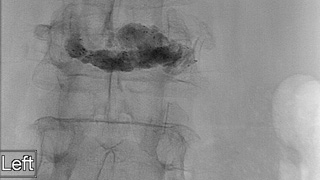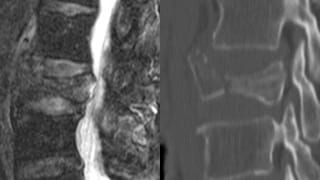Vertebral Augmentation and SpineWand
Imaging Service for Providers
Vertebral Augmentation
- For symptomatic relief of painful osteoporotic compression fractures.
- Performed under fluoroscopic guidance.
- Cannulae placed in transpedicular or parapedicular fashion into vertebral body.
- Mechanical cavity creation for low pressure cement injection.
- Cement deposition under fluoroscopic guidance.
- Cement hardens within 15 minutes to stabilize fracture for pain relief.
SpineWand
- For symptomatic relief of painful pathologic fractures in vertebral body.
- Performed under fluoroscopic guidance.
- Cannulae placed in transpedicular or parapedicular fashion into vertebral body.
- Ablative cavity creation using SpineWand coblation for low pressure cement injection.
- Cement deposition under fluoroscopic guidance.
- Cement hardens within 15 minutes to stabilize fracture for pain relief.
For vertebral augmentation for symptomatic osteoporotic compression fractures; under image guidance, large needles (cannulae) are placed into the fractured vertebral body. A cavity is created in the bone using an osteotome to allow low pressure injection of cement. Cement is injected under fluoroscopic guidance. Cement is polymethylmethacrylate with barium to allow visualization under fluoroscopy. The needles are then removed and dressings applied.
For SpineWand for symptomatic pathologic compression fractures; under image guidance, cannulae are placed into the fractured vertebral body. A cavity is created using SpineWand coblation device (low temperature ablation) to create a cavity in the tumor causing the pathologic fracture to allow low pressure injection of cement. Cement is injected under fluoroscopic guidance. The needles are then removed and dressings applied. Any further therapy, including external beam radiation, may be performed after SpineWand procedure with no loss of efficacy
Patient Selection and Indications
For pain relief of symptomatic fractures in the vertebral bodies of usually the thoracic and lumbar spine. The aim is to stabilize the fragments and increase patient mobility and to decrease or eliminate the need for narcotic administration. Using the SpineWand technique, symptomatic pathologic fractures in weight-bearing or long bones can be treated.
Patient Preparation
The patient should be referred to Quantum Radiology Interventional Section for assessment of imaging history and physical exam. A thorough review of imaging history, medical history and therapy will be performed and the patient will be scheduled by Quantum for any required laboratory tests (PT/PTT, CBC) if not already performed within the last 30 days. The patient will then be scheduled for the procedure at a Wellstar facility (Kennestone, Cobb, Douglas). For inpatient consults, Quantum Interventional is available at Kennestone, Cobb and Douglas.
Contraindications
Unfavorable anatomy of fracture (retropulsion causing spinal canal compromise).

Reporting and Outcomes
Symptomatic pain relief is achieved in the vast majority of cases with improved functional status, increased mobility and decreased need for narcotics.
Both vertebral augmentation and SpineWand is well tolerated with very low complication rates.

